Xcel Energy has the exact wrong priorities and you deserve the freedom to switch companies
In a recent interview with S&P Global, Bob Frenzel, Xcel Energy’s President and COO outlined the company’s vision for the next nine years and it is clear that the government-approved monopoly utility has the exact wrong priorities for its customers.
As a result, policymakers in Minnesota must consider giving families and businesses the freedom to choose another provider that better suits their priorities. Unfortunately, Xcel’s priorities and those of their customers are simply not aligned.
The Wrong Priorities
The interview begins with Mr. Frenzel discussing the three strategic priorities of Xcel Energy:
We are guided really by three strategic priorities: 1) Lead a clean energy transition that is going on in the country, 2) Continue to enhance the customer experience, and 3) Keep our product affordable, available, and reliable.
Xcel’s priorities are in the exact wrong order. The company should be providing electricity that is 1) reliable, 2) affordable, and then 3) carbon-free.
Xcel’s priorities are California priorities. This means Xcel Energy is willing to prioritize building wind turbines and solar panels above providing reliable and affordable electricity to their customers. As we saw in California, these priorities result in rolling blackouts.
Performance in Texas
Xcel Energy has subsidiaries in the Upper Midwest and several Southwestern states, including parts of Texas. Some of Xcel’s natural gas plants were unable to run in February in the Southwest because they were unable to get natural gas:
Like many of the companies in ERCOT, though, we struggled to get natural gas to some of our natural gas-fired power plants, and some were unable to run. However, we exported power from our Northern States Power Company into MISO, and even in Colorado, our company was exporting power to the broader state through the crisis. So, our plants ran exceptionally well, and we were happy to support our neighbors like this industry has a hallmark of doing.
Xcel paints a rosy picture about the company’s ability to provide enough electricity for its customers, but this description conveniently side-steps the fact that it was the coal plants on Xcel’s system that enabled them to send power elsewhere, and this option won’t be available after 2030.
The graph below is from the Energy Information Administration, and it shows electricity generation in Xcel’s Colorado service territory from February 1, 2021, through February 23, 2021. As you can see, wind generation disappeared for eight consecutive days, and Xcel’s coal fleet needed to run constantly because renewables were “reliably unreliable.”
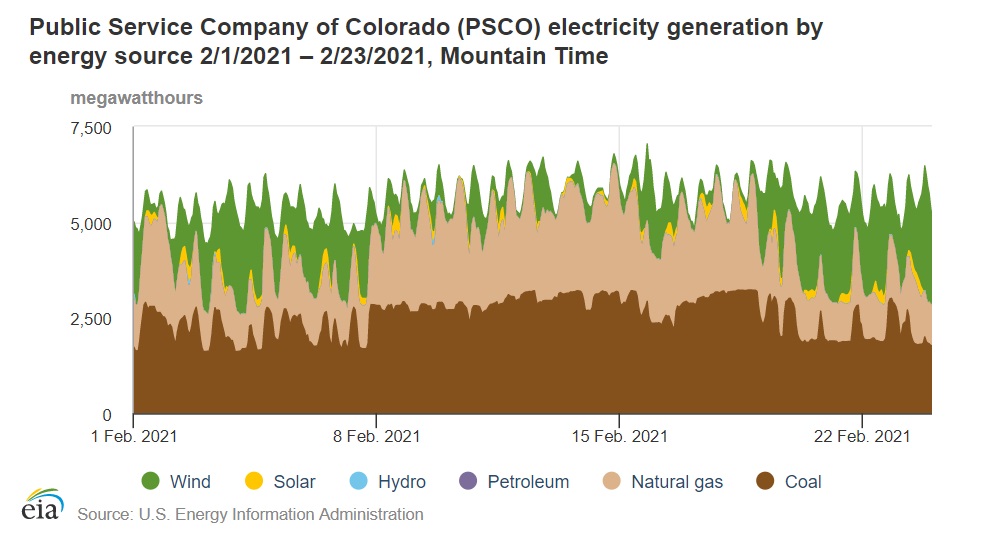
Xcel is playing similar games with reliability in Colorado and Minnesota. In Colorado, the company is seeking to prematurely retire the coal-fired generators at the Comanche station, and in Minnesota, they are doing the same with their Sherburne County and Allen S King plants.
The Role of Regulations:
In the interview, Mr. Frenzel was asked: “Was there a regulatory climate that was more constructive early on that enabled you to make headway in certain jurisdictions?”
He replied:
We have been a leading provider of wind for 15 years, and that has happened predominantly in the upper Midwest and in Colorado. We are fortunate to sit in some of the windiest areas of the country, and some of the best solar resources as well, making this transition to a lower-emissions profile very cost effective because of the resource rich areas that we serve, and we have been able to keep our customer bills flat for the past five years. We expect by the end of the decade to be able to make this entire transition for less than the rate of increase in inflation
Mr. Frenzel pretends that the company’s rush to renewables was the result of good wind resources but the real reason is renewable energy mandates.
Minnesota signed its renewable energy mandate, which required 25 percent of the state’s electricity to be “renewable” into law in 2007. This bad legislation required Xcel to be 30 percent renewable by 2020, while it allowed Minnesota’s other utilities to achieve a target of 20 percent renewable at a later date.
Since this time, Minnesota families with Xcel Energy saw skyrocketing electricity prices, as you can see in the graph below.
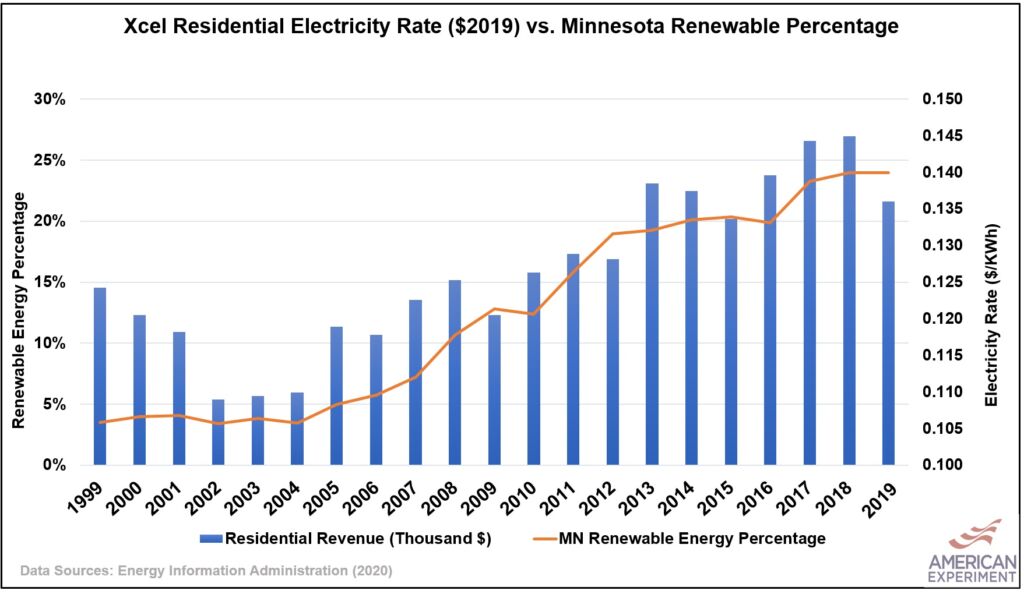
It’s important to note that prices only look lower in 2019 because Xcel sold less electricity than it anticipated that year, but electricity costs will increase again as Xcel is seeking to raise electricity prices by 20 percent to make up nearly $600 million in revenue.
Colorado has similar mandates for unreliable wind and solar power, requiring investor-owned utilities (IOUs) like Xcel to get 30 percent of their electricity from wind or solar by 2030 and requiring 100 percent “clean energy” by 2050 for utilities serving 500,000 or more customers.
There is no getting around the fact that state mandates, federal mandates, and abusive profit-seeking tactics from Xcel have been the leading reason for Xcel Energy to build more wind and solar facilities.
Further evidence for these factors comes from the fact that Xcel plans to build thousands of megawatts of solar over the next two decades, but Minnesota has terrible solar resources, as you can see in the map below.
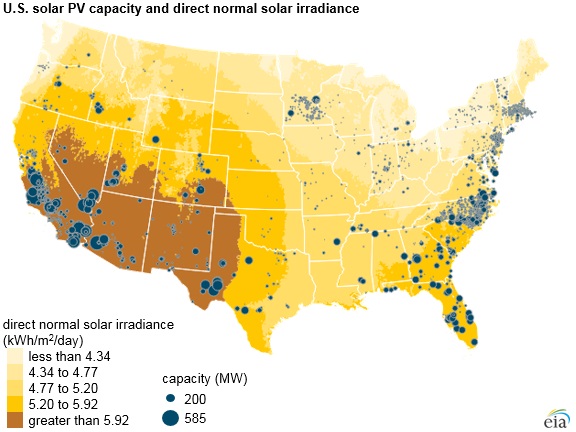
It is Minnesota’s solar energy mandate, federal tax incentives, and the pursuit of government-guaranteed profits from the rate base that incentivize the company to keep adding solar to its system, not the quality of these resources.
Sadly, it is families and businesses who ultimately pay the price.
Customer Costs
Mr. Frenzel claims that consumer costs have been flat for the last five years, but this isn’t true of Xcel Energy residential electricity customers in Minnesota, who have seen their bills increase by 5 percent since 2015, as you can see in the graph below. When comparing 2018 with 2015, residential electricity bills were up by nearly 15 percent in just three years. As such, the trend for customer costs at Xcel has been anything but “flat” from 2015 to 2019.
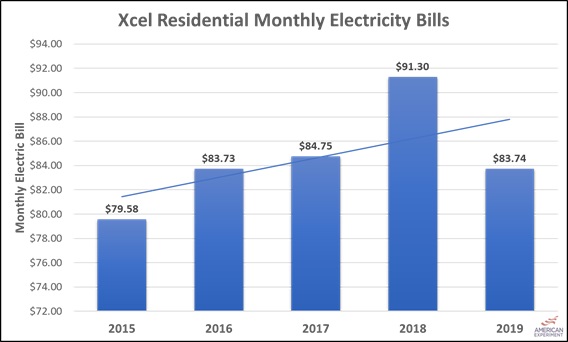
Again, it is vitally important to understand that the graph above does not account for the massive increase in costs that Xcel is planning on imposing on its customers. Accounting for the upcoming increase in electricity rates, Minnesota electric bills would be $109 per month.
Xcel is also very deceptive about how they discuss bills on their website. Xcel claims that their customer’s bills are 24 percent below the national average, but they fail to mention that their customers pay much more for each unit of electricity they use, as you can see in the graph below.

This means Minnesota families with Xcel aren’t getting a deal on their electricity, they’re getting taken to the cleaners.
Total bills for Xcel customers are lower than the national average not because the cost of electricity through Xcel is lower, but because they use much less electricity than the rest of the country. This is largely because most Minnesotans use natural gas for home heating, and have fewer days where they run their air conditioners.
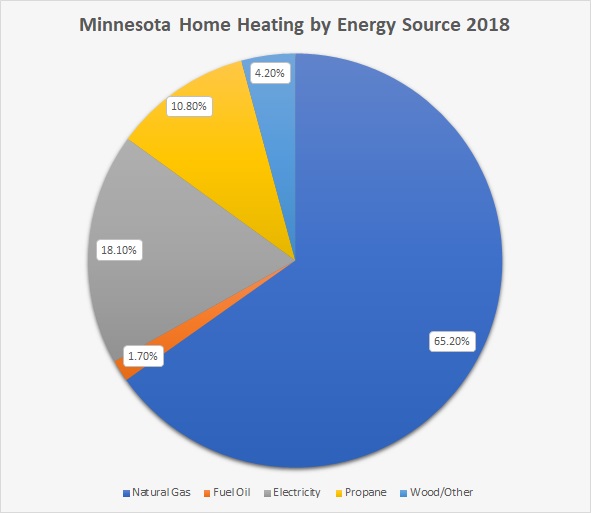
Would anyone think that Californians are getting a deal on their gasoline if gas prices are so high they can’t afford to buy as much of it? Of course not, but this is what Xcel is doing when they brag about their bills being below the national average when it is due to the fact that Minnesotans use less electricity than people living in other states.
What’s interesting is that Minnesota families have seen their electricity bills increase even though they use far less electricity than they used to.
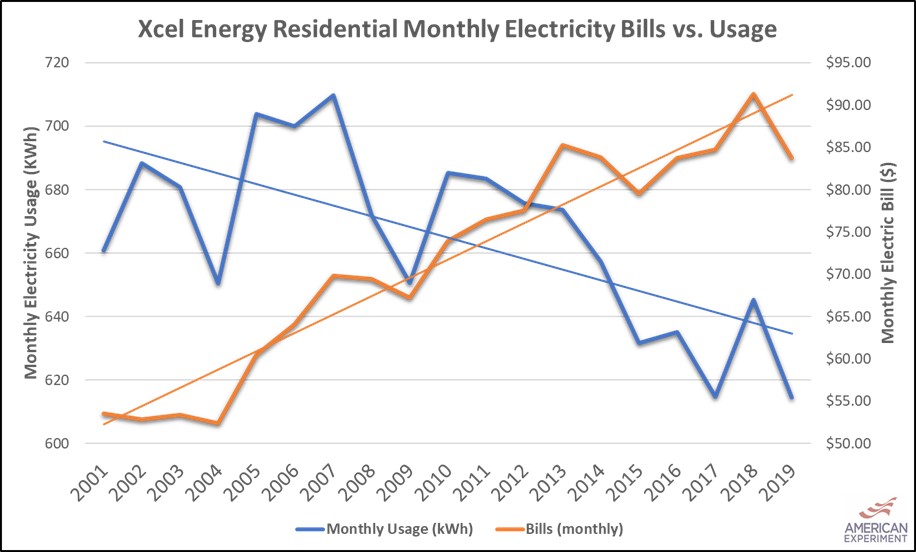
Spending Billions of Your Money
Xcel also details how the company will be spending $1.5 billion repowering wind turbines and building nearly 500 megawatts of solar panels at the “Sherco Solar,” facility. These costs will be passed directly on to you and your family, plus a government-guaranteed profit of 10 percent.
However, this is just a small slice of the money Xcel expects to extract from you over the next 30 years. American Experiment has concluded that the company’s plan to shutter its coal plants and replace them with wind, solar and natural gas will cost an additional $57 billion compared to today’s costs. This will increase annual electricity bills by an average of $1,400 for each of Xcel’s customers – which is roughly $200 more per month than the average rent of a one-bedroom apartment in Minneapolis.
Electric Vehicle Rebates for the Rich
Xcel spoke of their desire to get more electric vehicles in their service territory, but this is mostly so they can own the infrastructure, pass the costs on to their customers, and cash in on their guaranteed 10 percent profit. The company has also stated it wants to give electric vehicle rebates to purchasers, which would also be paid for by ratepayers.
This is just plain wrong, because EV buyers are much wealthier than the average household, meaning low and middle-income families will have to pay more money on their electric bill each month to subsidize someone else’s Tesla.
Xcel Energy customers are locked in an abusive relationship with a government-approved monopoly utility that puts its customers last on its list of priorities. Instead of maximizing economic opportunities for all Minnesotans by keeping prices as low as possible, the company is seeking to pad its government-guaranteed profits as much as it can and then act like they are doing their captive customers a favor.
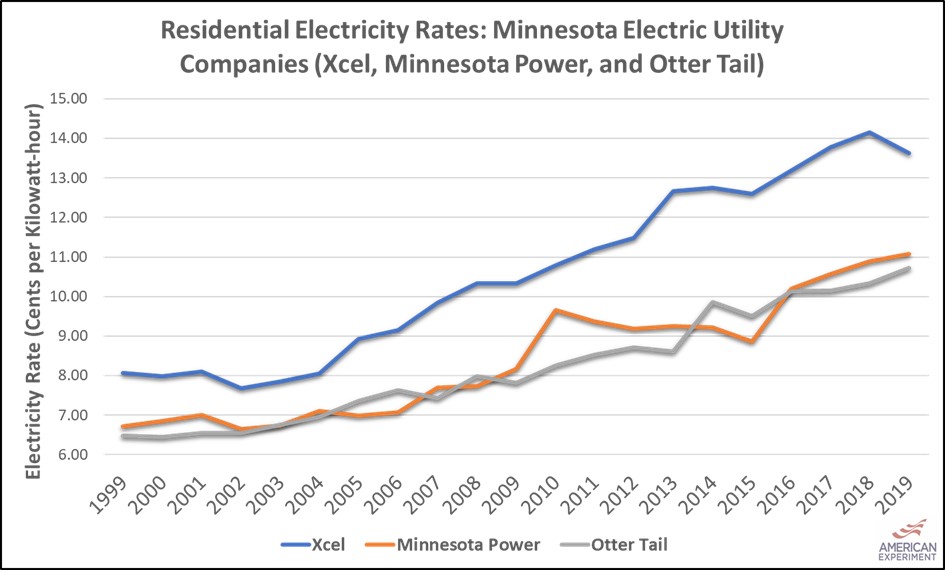
Electricity should be reliable, affordable, and carbon-free. In that order.
If Xcel Energy refuses to prioritize reliability and affordability, Minnesotans need the freedom to choose another provider that will. Based on the graph above, Otter Tail Power Company and Minnesota Power would be attractive options. Xcel will only stop its shenanigans when it can lose you as a customer. The sooner Minnesotans are free to choose, the better.